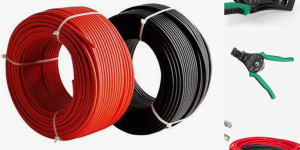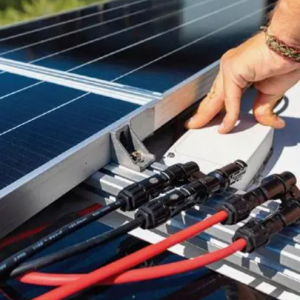You’re standing there, gazing up at the sun, its rays warming your face, and you’re struck by a thought: harnessing this power could be a game-changer. Solar energy, the gift that keeps on giving, is now a reality in many homes and businesses. But before you can start reaping the benefits, there’s a crucial decision to make – choosing the right Solar cable size and type. This isn’t just about connecting panels; it’s about ensuring efficiency, safety, and longevity in your solar power system. Let’s dive into the world of solar cables and PV cables, and how to pick the perfect match for your renewable energy setup.

The Power of Solar Cable and PV Cable
Solar cables and PV cables are the unsung heroes of solar power systems. They’re the veins and arteries that carry the electrical current from your solar panels to your home or business. Just like choosing the right type of wire for a home theater setup, selecting the right solar cable is crucial for maximizing the performance and safety of your solar installation.
Understanding the Basics
Before we get into the nitty-gritty of cable selection, let’s cover some basics. Solar cables, also known as photovoltaic (PV) cables, are designed to handle the unique demands of solar power systems. They’re made to withstand exposure to sunlight, moisture, and temperature fluctuations, which are common in outdoor environments. The insulation on these cables is UV-resistant and often has a jacket made from materials like TPE or EPR, which offer flexibility and durability.
Sizing Up Your Needs
When it comes to sizing solar cables, you’re not just looking at the thickness of the cable, but also its ampacity – the maximum current it can safely carry. This is determined by the wire gauge, which is measured in American Wire Gauge (AWG). A lower AWG number indicates a thicker wire, which can handle more current. For residential solar systems, cables typically range from 10 AWG to 4 AWG. However, the size you need will depend on the specific requirements of your system, including the number of panels, their combined output, and the distance the cable needs to travel.
The Role of Voltage
Voltage also plays a significant role in cable selection. Higher voltage systems can use smaller cables because they require less current to deliver the same amount of power. This can be an advantage in terms of cost and installation complexity. But remember, the cable must be able to handle the voltage without risk of failure or damage. Always consult with a professional or use a cable sizing calculator to ensure you’re choosing the right cable for your system’s voltage.
Temperature Considerations
The operating temperature of your solar cables is another factor to consider. Solar installations are exposed to a wide range of temperatures, from scorching summers to freezing winters. Cables rated for higher temperatures will last longer and perform better in these varying conditions. Look for cables with a temperature rating that matches or exceeds the expected ambient temperatures in your location.
The Importance of Flexibility
Flexibility might not seem like a big deal, but it’s crucial for solar cable installations. Cables need to be flexible enough to handle the movement and expansion that occurs with temperature changes, especially in large solar arrays. A flexible cable will reduce the risk of damage and ensure a reliable connection between your solar panels and your inverter.
Choosing the Right Insulation
Insulation is what protects the cable’s conductors and ensures the safety of your solar power system. Solar cables should have insulation that is resistant to UV radiation, ozone, and chemical degradation. This protects the cable from the harsh outdoor environment and extends its lifespan. Look for cables with insulation made from materials like cross-linked polyethylene (XLPE) or ethylene propylene rubber (EPR), which offer excellent protection and performance.
Long-Term Durability
When you’re investing in a solar power system, you’re thinking long-term. You want cables that will stand the test of time. Look for solar cables with a long lifespan and a manufacturer’s warranty to back it up. This will give you peace of mind knowing that your investment is protected and that you won’t need to replace your cables any time soon.
Safety First
Safety is paramount when dealing with electricity, especially in a solar power system. Ensure that the solar cables you choose meet all the necessary safety standards and certifications. This includes being halogen-free, which reduces the risk of toxic gas emissions in case of a fire. Always check for certifications like UL, IEC, and CE to ensure that your cables are up to code.
The Impact of Cable Length
The length of your solar cables can have a significant impact on the efficiency of your system. Longer cables can lead to increased resistance and energy loss. To minimize this, choose the shortest possible cable runs between your panels and your inverter. If long cable runs are unavoidable, consider using cables with a larger gauge to reduce resistance.
Matching Cable to Panel Output
Each solar panel has a specific output, and the cable you choose should be able to handle this output without being overwhelmed. Overloading a cable can lead to overheating and potential failure. Always check the maximum current rating of your cable against the combined output of your solar panels to ensure a safe and efficient connection.
The Future-Proofing Factor
As solar technology advances, you might find yourself wanting to expand your solar power system in the future. When choosing your solar cables, consider their ability to handle increased loads. This will make it easier to add more panels or upgrade your system without having to replace your cables.
Wrapping Up
Choosing the right solar cable size and type is a critical step in setting up a solar power system. It’s not just about making sure your system works; it’s about ensuring it works safely and efficiently for years to come. By considering factors like cable size, voltage, temperature ratings, flexibility, insulation, and safety certifications, you can make an informed decision that will benefit your solar power system in the long run. So, the next time you’re out there, basking in the sun’s glory, remember that the right solar cable is the key to unlocking the full potential of your solar investment.




